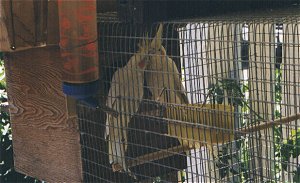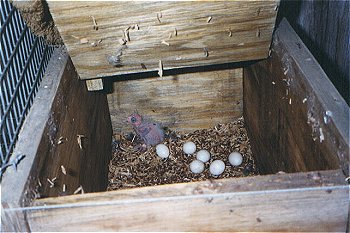

Starting Out
1) Read as much as you can about the species you're going to breed.
 2) Make sure you have a true pair. Some species cannot be sexed visually
(dimorphic species can) and must be DNA sexed. (hint: see sexing)
2) Make sure you have a true pair. Some species cannot be sexed visually
(dimorphic species can) and must be DNA sexed. (hint: see sexing)
3) Make sure your birds like each other. Some species (particularly the larger ones) can be picky about their mates. Unhappy couples are more likely to have problems.
4) Provide a healthy diet and increase the amount of food. Make sure they have access to cuttlebone and/or mineral block. Some foods you should provide: bean mix, veggies, fruit, wheat bread, scrambled eggs with the shell, Crazy Corn, etc. (hint: see diet)
5) The cage should be very roomy. Some birds feel more secure when placed at or above eye level.
6) Buy or make an appropriatly sized nestbox and attach it to the cage (the higher the better). Make sure it's easy to access. Add a layer of pine (NOT cedar) shavings to the bottom. This bedding will need to be changed every so often after the babies arrive as it will get rather soiled.
7) Make sure you know a good breeder and veterinarian to help you with any problems you might encounter.
 8) Since you are a beginner, I would advise letting the parents do the work and not trying to
raise them yourself. Handfeeding is a difficult and stressful process that requires good
experience.
8) Since you are a beginner, I would advise letting the parents do the work and not trying to
raise them yourself. Handfeeding is a difficult and stressful process that requires good
experience.
Eggs
1) Many times a pair's first clutch will be infertile or will contain infertile eggs.
2) If you don't live in a very humid area, it is a good idea to spray the lid (on the inside) of the nestbox with water for a few days before the eggs hatch.
Chicks
1) Chicks hatch naked, blind, and wrinkled. They may look deformed at first, but they stop looking as strange when they get larger.
2) Band your babies for identification purposes when they reach the correct age. Write down which chicks hatched when, under what parents, and any other useful information. You may remember it now, but you won't later. Some states require certain species to be banded. In California budgies cannot be bought or sold without appropriate bands. (hint: see banding)
3) Make sure the chicks are well attended to and that their crops are full.
Afterward
1) It's always a good idea to keep a few babies for future breeding stock.
2) You can usually let the more prolific species have three clutches in a row (don't do this if they seem stressed though). After that they will need at least a six month break. Some birds will keep trying to breed until you remove the nestbox.
3) Disinfect the nestbox by emptying it, soaking it in bleach water, and then letting it dry in the sun.
4) If your pair breeds in a smaller cage, you may want them to get back in good health by placing them in a flight during the off season.

© 1997 birdbrain75@hotmail.com